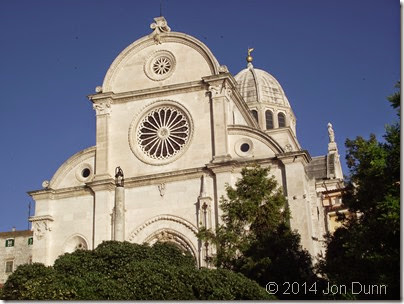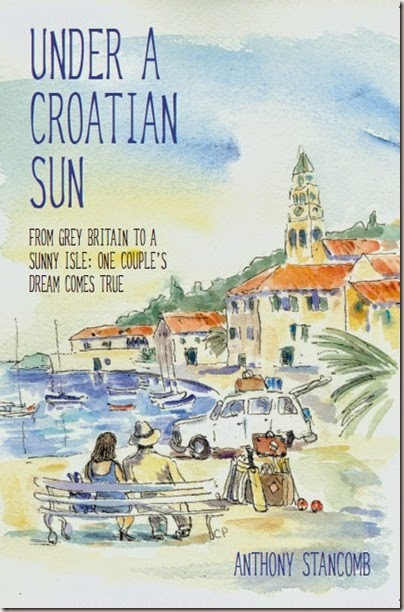Croatia In May–A Traveller’s Report
Today’s posting and photos are from Jon Dunn who we “met” on Twitter [ @cromercanary ] and loves Croatia as much as we do. Jon has just returned from a trip around one of the most unspoilt parts of Dalmatia and was kind enough to let us post the first part of his travel report. Please note that opening times, ferries and bus timetables vary according to the season and you might be hard pushed, for example, to find any boat to take you up the Krka River if you go there in February!
***
North and Central Dalmatia, May 2014.
Hi, I’m Jon, from Cromer in Norfolk in the U.K. For several years now (since my first visit to Istria, in fact) I’ve had a “thing” about Croatia. That time, I was based in Pula, but had visits to Rovinj, Poreč and surrounding areas.
In 2012, I was diagnosed with cancer of the epiglottis, which was caught early and treated successfully - fingers crossed. So in May last year I had recovered enough to travel to Dubrovnik and Korčula, which were (and still are, I assume) both fantastic. Looking at the map, I saw there was a massive chunk in the middle of the country where I’d never set foot - something I was determined to resolve this year.
So the organising began in earnest. Where to fly to, stay, what to see and do, etc. These two websites were invaluable in helping this planning stage :-
So, anyway, I eventually sorted out an itinerary that looked feasible - and great fun. First stop Zadar airport from London Stansted. From there it was straight down to Šibenik to spend four nights in my first ever Airbnb accommodation (more of Zadar later). Šibenik is built on the side of a steep hill, so is quite demanding, seemingly never ending flights of steep steps. But boy, if you have appropriate walking boots on, it’s great. My rented room was perched high above the city, yet only five minutes walk from the waterfront. As it was getting late I settled for a pizza, from Pizzeria Fontana, Kralja Zvonimira 17a, 22000, which for 30 Kunas, was fine.
The early morning views across the sea from my balcony were to die for! St Ante’s channel and the islands of the Šibenik archipelago gleaming in the morning sunshine :)
There’s a helpful tourist office on the ‘riva’ (seafront promenade) just a few doors down from the Jadrolinija ferry office, which had brochures in several languages and a good city centre map. So, primed with a couple of macchiato coffees and some fritules (doughnuts) it was time to wander, get lost, discover forts, monasteries, medieval Mediterranean gardens, a beautifully kept cemetery (St Ana’s) and an endless supply of churches.
One of the main reasons for opting to use Šibenik as a base - it’s not the prettiest city in Dalmatia, with respect - was Katedrala sv. Jakova (St James Cathedral) which is totally stunning and benefits from UNESCO heritage status. It’s unique in as much as it’s constructed totally from stone, limestone quarried locally and marble brought in from Brač island. No bricks or timber were used.
The intricate carvings at the main and side doors were just staggeringly ornate, featuring massive Venetian lions but the quirkiest feature is the 71 life sized carved human heads forming a frieze around the outside. Who these people are/were is not certain, but they all manage to look in different directions and are a photographer’s dream!
Some more wandering for photos and a refreshment stop - the local red wine Babić became a pretty good friend and some of the best is produced in and around Šibenik – and I jumped on a bus to visit the picture postcard peninsula town of Primošten, which is charming and compact, but doesn’t warrant more than a couple of hours, in my opinion. Once again it’s a photographer’s paradise, especially if you carry on heading south and look back at it from there. The best Babić vineyards are just outside the town, so it would have been rude not to!
Back to Šibenik on the next bus, interestingly this bus service was run by Autotransport d.d. Šibenik (white buses with blue writing) and was literally half the price of Autotrans for exactly the same journey? Go figure.
By now I was starving. My ‘Rough Guide’ had mentioned konoba Tinel as a good place to eat and having tasted my first ever Pašticada with gnocchi, I have to agree with them. Tinel is tucked away a bit, opposite St Chrysogonus' Church (Galerija sv. Krševana - number 14 on the free tourist map) with a lovely raised outdoor terrace and comfortable indoor seating on two floors. Excellent.
The other reason for choosing Šibenik as a base is it’s proximity to Krka National Park. There’s a local service every morning from the bus station to Skradin at 9.00 I think, with a bus back at 17.00 ideal for a full day excursion to this stunning park. Skradin itself is worth a wander and apparently some of Dalmatia’s top wines are from there, but not enough hours in the day, sadly :(
From Skradin - there’s a reception and visitor centre in Skradin where you buy tickets for boat and park admission combined (90 Kunas adult) - hourly boats head up the Krka river to the end of that navigable stretch, Skradinski Buk waterfall. Forget all the photos, just go and see/feel/experience the thunderous wall of water spilling all around you! Spectacular is an understatement. There’s also a boardwalk of almost 2 km in length which the brochure says is a leisurely hour’s walk - I took more than three! Apart from the cascading water everywhere, there are numerous other attractions within the park, like weaving looms, blacksmiths, flour mills, even the remains of Croatia’s first ever hydroelectric power station. There are guides on hand to explain how it all used to work, and a woman weaving beautiful blankets on the loom.
In addition, as you make your way around the boardwalk, information boards telling you of all the rare and endemic plants, fish, mammals and birds which have been spotted in the park. There are additional boat trips further up the river to another massive waterfall, Roski Slap and a monastery on an island, but due to the timings of everything, you can’t really do it all in one visit, though there are places to stay overnight in the park and in Skradin. A fantastic and informative day for people of all ages.
Back to Šibenik and seafood risotto washed down with white wine - Istrian Graševina - delicious. (The plan was the black risotto with cuttlefish ink, but I had a change of heart - wimp!)
There’s only one regular Jadrolinija ferry service from Šibenik, to the ‘resort’ of Vodice, calling at the islands of Zlarin and Prvić en route. I wanted to visit a small, rectangular town called Tribunj, which is the epitome of cuteness. The ferry leaves Šibenik at 09.30 and returns from Vodice at 18.00, which again allows for a full day exploring. Tribunj is about four km from Vodice, but it’s a gorgeous walk along the beach path which is paved for most of the way. The marina is awesome, filled with some of the most luxurious boats I’ve ever seen. There’s a narrow causeway bridge linking Tribunj with the mainland, much like Primošten, and it’s a great place to wander. The old town on the islet is not much bigger than a football pitch, so you’ll be doing well to get lost! There are some cool waterside bars, such as Nautica, a great place to sit and watch the boats come and go, listening to some of the most chilled out music I’ve ever heard. Bliss!
The best vantage point and worthy of a visit is the hill behind the town, where you can find the ruins of a Venetian fortress and the lovely little church of St Nicholas.
Back along the beach path to Vodice for the ferry home, but not without a typically enthusiastic Croatian wedding taking place, car horns blaring, then a walk around the seafront with accordions serenading the happy couple :)
***
Many thanks to Jon for his report on the first part of his travels and I am looking forward to the next. Makes me rather homesick for Croatia - Šibenik was my home for several months and when we first went to Croatia, in 2002, to find a house to live in, we stayed right by Tribunj “Marina” for a week. There was no swish marina then, just the shell of an enormous building (that became the marina offices) abandoned half way through construction.
For more information on some of the places Jon describes, the following links will take you direct to a few of our earlier postings on this blog and sister blog, Croatia Cruising Companion:
Croatia On Line - Gastronomy Near Šibenik
Croatia On Line - Falconry Centre Near Šibenik
Croatia Cruising Companion - Šibenik In Winter
Croatia Cruising Companion - Šibenik Regatta



